How Roni Horn Taught Me to Cruise on the Down Low
Matt Morris considers the work of artist Roni Horn, the aesthetics of gay hookup app Grindr, and more expansive ways of thinking about selfhood.
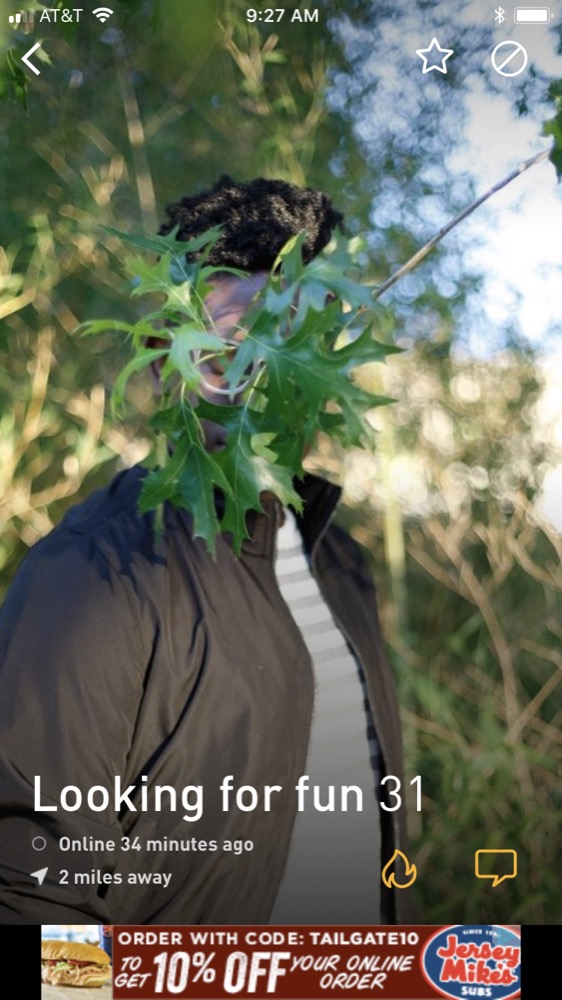
All screenshots by the author.
One day I was browsing Grindr and saw a photograph of a man whose face was hidden behind a lush, leafy tree branch. His profile was captioned “Looking for fun.” Typically when one signs into Grindr, a mosaic of images cascades from the top edge of the smartphone screen—a grid of profiles of other users, primarily men, in relative proximity to one’s current location. The platform’s visual codes demonstrate frank eroticism. Shiny, defined abs predominate. While full nudity is forbidden by the app in publicly shared images, “visible penis lines”—that is, the impression of a penis through underwear or pants, VPL for short—abound. Youthfulness (or the affectation of youth) is signaled through clothing, pose, and setting—such as clingy t-shirts and tanned arms, shown in a sea of bodies in a dance club. So the occasion of this figure obscured and abstracted with foliage gave me pause and sensitized me to the many other bodies overlapping with landscape photography, sometimes hiding a figure, other times posted in lieu of a portrait. My hope is that a formal visual analysis will help articulate not only the modes of sexual engagement on this social media app but also the philosophical effects of how bodies and their orientations may be conceived in more complex ways in relation to space.
Art historically, the categories of portrait and landscape have been treated as mostly oppositional. (Think of the carryover of their use for page orientation on printers: this way or that way.) More than just a conceptual division, landscapes have long been instrumentalized as a tool for visualizing the authority of the (human) bodies that territorialize space. Eras of expansionism, imperialist colonialism (and its succeeding, often more insidious forms), and manifest destiny have all apprehended lands and waters as materials over which humans exert mastery and authority. Idealized nature photography such as what I find on Grindr, while contextualized differently, plays to conventions of romantic and sublime expeditions across climate zones and suggests escapism to exotic locales—images that have helped produce widely-held conceptions of nature.
More recently, artists have used landscape imagery with experimentation and cultural specificity to demonstrate the sociological function of nature. Think for example of Andy Warhol’s flower paintings of the 1960s and the camouflage paintings of the 1980s: In both cases, queerness, camp, and audacious fashion subvert the pressures to hide or disappear that characterized queer life for much of the 20th century. Ana Mendieta’s Silueta works from the late 1970s document her means of marking landscapes with impressions of her own body and symbols of feminine divinity. And American artist Roni Horn, whose work serves as a lens for this text’s analysis, has built a decades-long relationship to the landscape of Iceland and the particulars of its geology. Relatively young as land bodies go and situated on a border between tectonic plates, the island’s landscape is characterized by ongoing volcanic and geothermal activity. Horn has worked with and from those qualities to make photographic and sculptural installations that intersperse figurative and landscape images in ways that are conditioned by mutability and doubt and that eschew categorical forms of knowledge.
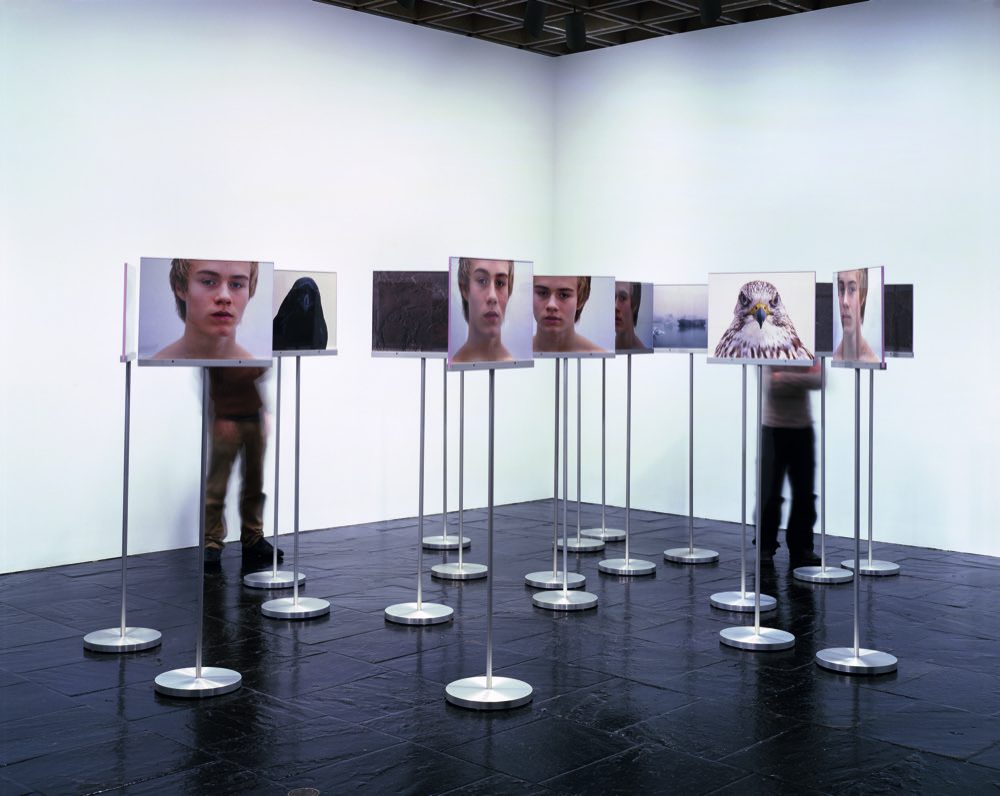
Installation view of Roni Horn’s Doubt by Water (Who), 2003–04, at the Whitney Museum of American Art, New York. Thirty double-sided pigment prints in plastic sleeves on aluminum stanchions. Courtesy the artist and Hauser & Wirth, Zürich. Photo by Bill Jacobson.
A recognition of the ways that outdoor spaces are constructed through our projected ideologies and physical interventions is vital to rethinking how desire is enacted and to reimagining the boundaries that have been used to define figures and landscapes, bodies and spaces. Approached with these terms of engagement in mind, Grindr is not so strange a site in which to notice the defining relations between body and space. It’s perhaps especially apropos to encounter questions of interrelatedness that upend traditional notions of landscape’s subordination to man in a virtual environment that is visualized only through the proximities of its users’ bodies.
Nearly a decade since Grindr’s inception in 2009, the application has become a commonplace fixture within gay and queer sociality. While the stated purposes vary (in-app options include: chat; dates; friends; relationship; networking, which is mostly used in jest; and the suggestive right now), it’s generally accepted that Grindr users are more transparent about their pursuit of casual sex than competitor dating apps like the more hetero-oriented Tinder.
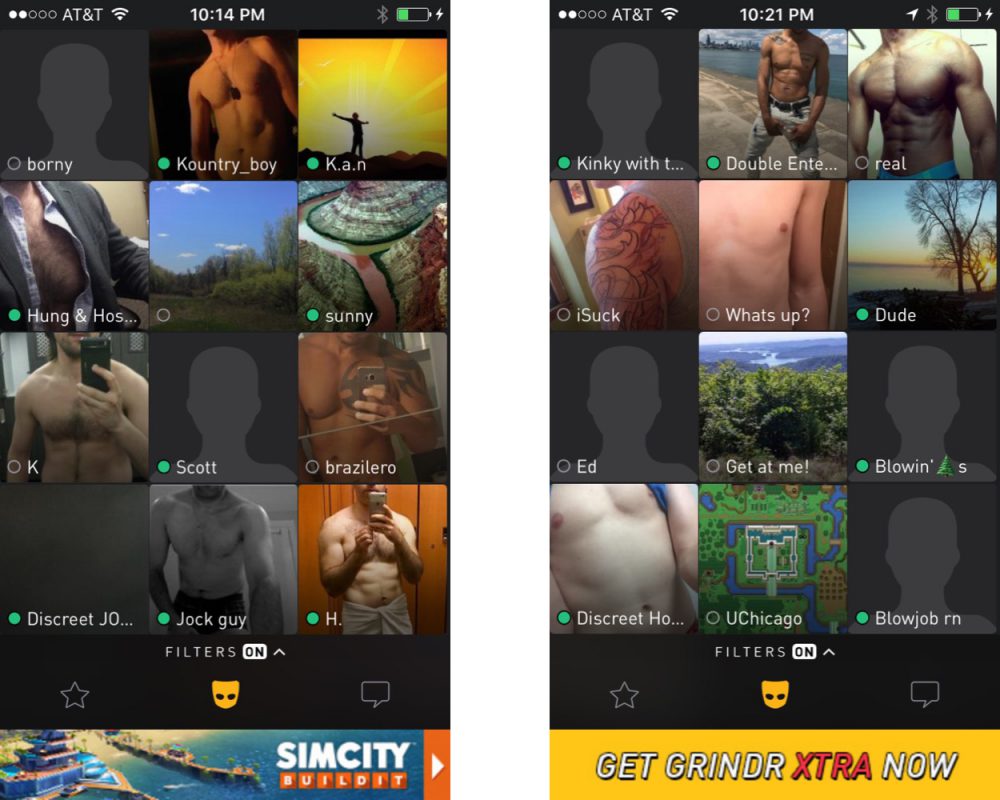
Slang and jargon inscribed into the profiles compound the articulations of desire expressed in these montages: LOOKING (shorthand for looking for sex), GEN ONLY (sex workers seeking financially “generous” men), MASC 4 MASC (men only looking for other conventionally masculine men), BBC (“big black cock,” one of a plethora of racialized reductions), NO FATS, NO FEMS, NO ASIANS (about as narrow of a taste as it sounds), DL (short for “down low,” a term originally used by African-American men presenting themselves as straight and secretly having sex with other men), and, relatedly, DISCREET (secretive about identity, often not “out,” rarely shows face or other identifying features in any images).
It would be hard to say that Grindr is a pleasant social environment. It’s common for profile texts to deprecate the entire experience with complaints about how users treat one another and threats to give up on the platform altogether. And for as many profiles that warn that they will block someone for rudeness, there are just as many that argue that they maintain the right to issue harsh criticism toward those who fall outside the strictures of their own tastes. It is masculinist in the extreme, frequently privileging exactly the mode of gender performance that social stigmas presume that gay men fail at embodying. Ego is rampant. Deception is rampant. (The term “catfish” denotes the enacting of false identities often using appropriated images from more objectively “sexy” users.) Racism is rampant, particularly since 2012 when Grindr users could upgrade to a paid membership, which allows profiles to be filtered by race and other categories, so that profits are generated from the biases of its users.
For my trans and more visibly gender-nonconforming friends, the unsolicited feedback they receive from other Grindr users is frequently more deliberately antagonizing and verbally violent than what those friends face in their navigation of public spaces outside of the app. To be perfectly honest, I deleted my Grindr account during my research for this essay. I had begun to use it during graduate school in 2011 in the pursuit of a fairly self-indulgent art project I titled sex on campus, and over the past six years have used it to complement my primary relationship with casual sex, sometimes with recurring partners, but often with anonymous strangers I will likely not encounter again. But my need to resist toxic masculine spaces prevailed over the other forms of wanting that brought me to this platform.
Grindr marks, for me, a historical moment of confluence that draws upon prior conventions of cruising (searching for casual sex in public) and anticipates, however unwittingly, burgeoning conceptions of self and being that better account for our inextricable interrelatedness with ecological systems. Grindr uses geolocation software so one’s position in space figures into the user experience. The preceding virtual sexual landscape of the Internet differs from this model as porn sites, chat rooms, and other means of sexual gratification were and are located on the Web, within a network of links, pop-up screens, and the often desktop devices with which they may be accessed. Grindr and its ilk, by comparison, are not only tied to a virtual presence but also necessarily situated within the more public physical spaces in which one is located while accessing the platform. Location informs and dictates use of the app. The rationale is that proximity makes for a higher potential for (at least physical) intimacy.
This simultaneity extends beyond Grindr: Sometimes when I emerge from an underground subway station, I’ll open Google Maps and compare my movement to that of the dot representing my location on the screen, checking to see if I’m heading in the direction of my destination. In that moment I am both a body in the wilds of the world and an operative in the virtual plane of maps and moving dots within the application. In Grindr, space is collapsed into a crowd that reconfigures around a user in relation to movement through physical space. Fantastically, a collage is made and re-made as an elaborate effect of concurrent attempted sexual rituals. For much of the time, Grindr appears as a space made from nothing but bodies and fragments of bodies—warm flesh tones writhing into new arrangements with only skin as a marker of distance and closeness.
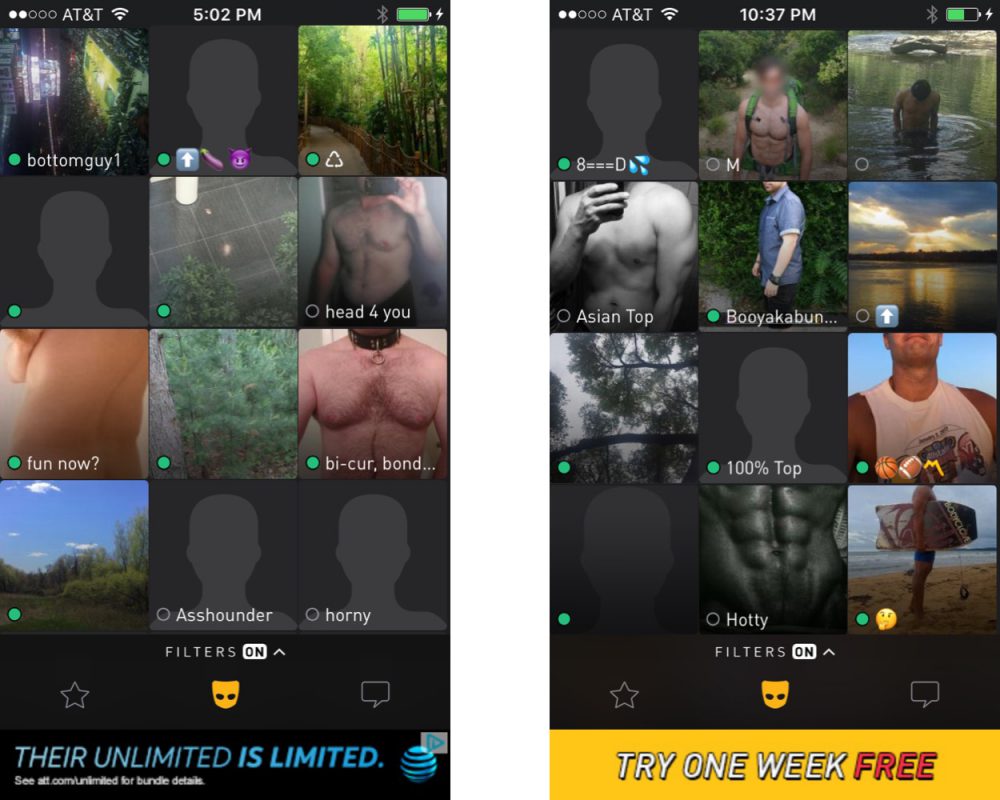
Into this relative homogeneity, occasional interludes of landscape grow. One day, within the grid, I saw a scantily clad man crouched behind a bush. On another day, multiple profiles showed male bodies stripped to their waists standing variously on a hiking trail, on a beach, and half-submerged in a green, rippling body of water.
Many histories are recollected through the visual combination of bodies among the bushes. Think back to the Ramble in New York City’s Central Park, a popular site for after-dark cruising as early as the 1920s, and actively used throughout the 20th century as a meeting grounds until a decline in the 1980s and ’90s during the AIDS Crisis. (The area continues to be used variously for cruising and birdwatching to this day.)
Why take to the forests? And how does this relate to the down low profiles on which such images commonly occur? The earliest laws criminalizing sodomy in the United States were written by Thomas Jefferson in 1779, and while Illinois led the move to decriminalize homosexuality at a state level in 1962, the U.S. Supreme Court didn’t invalidate all state sodomy laws until the summer of 2003, in Lawrence v. Texas. So while many gay and queer icons of art, literature, and public life were active and out during those 200 plus years, there was understandably often a great deal of risk and concern for having one’s sexual orientation discovered or made public.
During this period, when many queer people lived their lives within heteronormative conventions rather than risk becoming outlaws, outdoor and public spaces—despite the racing, sometimes erotic suspense of being happened upon—also constituted relative safety compared to the risk of discovery in, say, a family home or a hotel. Nature even appears in the original set of symbolic meanings assigned to the first rainbow flag, made by Kansas-born activist Gilbert Baker and waved at San Francisco’s Gay Freedom Day Parade on June 25, 1978. Baker’s bands of color were each assigned meanings and associations, for example: red for life, turquoise for magic and art, and green for nature. Core among the values of early Gay Liberation activism was a relationship to the larger ecological systems in which we are located.
For me, the Ramble and naturist values in early Gay Lib no doubt haunt—however obliviously—these landscape images on Grindr. But some of the sentiments resonate further, as profiles with outdoor imagery might state that they are hoping for public play. On other profiles, images of wooded trails might be captioned with the user’s desire for someone who similarly enjoys hiking and camping. Gay histories repeat across unfolding virtual locales. With an eye toward this lineage, I began to note encounters with landscape photography on Grindr with far more frequency on the profiles of users who self-describe with the aforementioned DL or discreet. Indeed, one of the tribes that can be selected on Grindr allows users to search particularly for discreet profiles.
The break from convention in using a photo of one’s own face or body as a profile image can be analyzed toward many ends. If this were a sociological study, I would perhaps aim to interview and index the motivations told to me by users that shape their decisions to prefer flora over fauna, and, often, open expanses of space rather than consolidated, discrete bodies. Much also could be said about shame, social stigma, secrecy, and sexual desire. But that isn’t how Roni Horn taught me to look at the phenomenon of these grids of photographs that intersperse bodily fragments with what, thus contextualized, read as similarly bodily landscapes. I approach these materials with formalism, producing meaning from the describable features of these screens of Grindr images in ways similar to how I have been trained (and, as an educator, also train others) to consider art and other forms of visual culture.
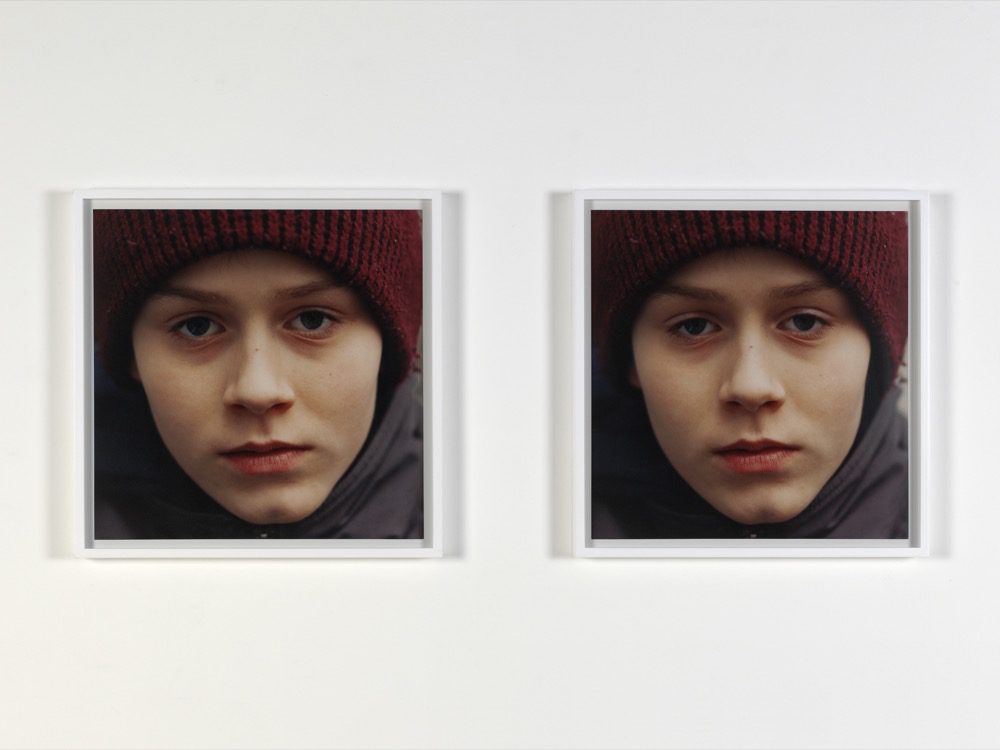
Roni Horn, Becoming a Landscape, 1999–2001. Twenty C-prints (detail). Courtesy the artist and Hauser & Wirth, Zürich. Photo by Stefan Altenburger Photography Zürich.
Throughout several decades, Horn has produced numerous photographic projects that give representation to forms of desire exceeding normative conceptions of desiring/desirable bodies, as well as challenging the very structures by which bodies are given shape in contrast to their surrounding environments. In the works here discussed, she situates various androgynous models in the context of the Icelandic landscape in such a way that shows identity as possessing all of the flux and instability that characterizes Iceland’s geology, rather than the fixity and solidly constituted conceptions of identity that appear to prevail in contemporary life. In Horn’s view, bodies flow into their surrounding space in a constant state of becoming, with fluid form and desires always in play.
Horn is one of numerous artists who have come to be read, from the 1990s onward, in relation to ideas of “queer formalism,” which were shaped by earlier explorations within feminist and Civil Rights movements to avoid representation in favor of embedding social, psychological, and identity-related investigations within abstraction and distilled visual codes. This loosely grouped milieu might also include Felix Gonzalez-Torres, Agnes Martin, Ellsworth Kelly, Zilia Sánchez, Ulrike Müller, Tom Burr, and more recently the work of artists like Sheila Pepe, Gordon Hall, Terence Koh, and Math Bass, among numerous others. In particular, Horn’s use of photography as a device that utilizes its spaces of display correlates to the sense of simultaneity of location that one experiences while using apps with geolocation software. Horn’s installations demonstrate strategies of discontinuity, fragmentation, substitution, and sensitivity toward how images are affected by their contexts. These became critical tools for comprehending the images on Grindr.
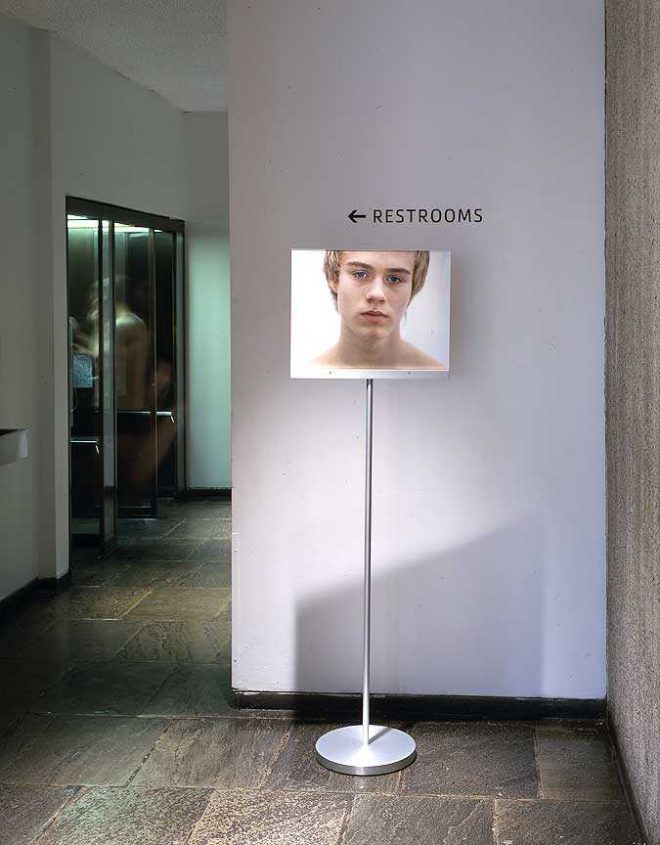
Installation view of Roni Horn’s Doubt by Water (Who), 2003–04, at the Whitney Museum of American Art, New York. Thirty double-sided pigment prints in plastic sleeves on aluminum stanchions. Courtesy the artist and Hauser & Wirth, Zürich. Photo by Bill Jacobson. Image via Art21.
I first saw Horn’s Doubt by Water (Who), 2003–04, at the 2004 Whitney Biennial. At the time, I had just started college. At that time, I had kissed a few boys but made no pronouncement about my sexual orientation—to myself or anyone else. As I entered the museum’s first floor, I saw elements of Doubt by Water before I knew it to be an artwork. Photographic pigment prints in plastic sleeves mounted atop brushed aluminum stanchions were, for this installation, dispersed throughout the building. Some were placed just inside the front doors to the museum’s lobby, positioned in relation to other stanchions cordoning off entrance to the galleries, or beside signage in the museum’s bookshop. They had the appearance of and impact like didactic or directional signage, but Horn poetically subverted any singular interpretation by depicting pale, washed out images of Icelandic shorelines and water channels, interspersed with closely cropped portraits of an androgynous youth’s face and similar portraits of birds’ heads. Each freestanding element was topped with photographs mounted back to back, so that as one moved around an element of the piece, a bird might be paired with images of icebergs, or an adolescent’s facial expression of quiet longing may be backed by an image of an uninterrupted field of water.
The places shown within the artwork are also understood in relation to the places in which they’re presented—a layering of the complex relationships one makes to the places they simultaneously inhabit. In the Whitney installation, one of the stanchions was positioned beside the public restrooms. The Nordic androgyne peers into the camera/stares out at the viewer. In this and other shots, the youth’s neck and shoulders are bared, mouth open slightly, as if sighing. This image isn’t necessarily sexually charged, but the beautiful, seemingly undressed figure is informed by its setting next to the bathrooms, and it likewise informs one’s impression of the bathrooms themselves—suggesting eroticism, public sex, and transformation within the institution of the the art museum, the art historical canon it signifies, and the building’s architecture.
One or two of the stanchions are placed here and there throughout the entire museum, cross-informing their contexts. These stand-alone fragments dismember the convention of the singular, reified art object, whose solidity has historically corresponded with similar individuating principles of selfhood. The repeated portrait, paired and combined with views of landscape, water, and wildlife, insists that there are multiple “me”s, multiple approaches to forming an identity. Coming to know anything is necessarily piecemeal and partial, and in Doubt by Water, this problematic reality is foregrounded through form. Here, understanding is a doubtful enterprise and identity is disoriented and fluid.
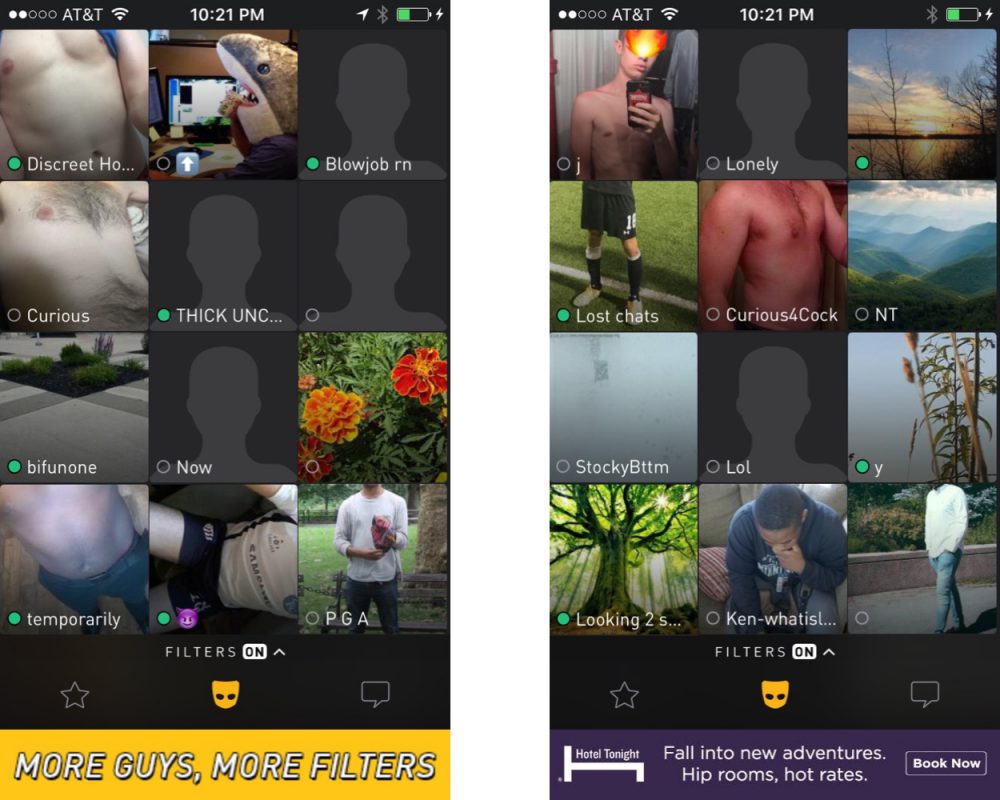
Rather than read the screens of tiled images on Grindr as indicative of discrete users congregating, I am compelled to consider the types of embodiment suggested from the groups of images together: six nipples, four hidden faces, marigold blossoms accenting the foliage, hairy skin, and green dots. One day I saw twelve profiles on my screen that together showed a bare, nubile figure whose face erupted in flame, just above a pair of legs standing on a grassy field; beside these body parts, a figure strolls along bushy flowerbeds and appears to have stalks growing from his neck at the spot where one image cuts away, conjoined to another one. Like the creature created in Mary Shelley’s Frankenstein, but in reverse, these compositions show not a body assembled but one deconstructed, the enclosure of a human body opened out upon the surrounding space, a dispersal of divergent fragments, like those in Doubt by Water. In both cases, an insistence is made for multiplicity.
In 2009, Horn’s work returned to the Whitney for her traveling retrospective. I returned, too. During the interim years since my first experience there with Doubt by Water, I had begun to be public about my sexuality, had begun the long-term open relationship of which I’m still happily a part, and would frequently get into debates about the use of terms like “gay” and “queer.” It was in this retrospective exhibition that I was able to experience another work, Becoming a Landscape, 1999–2001, in a gallery rather than in reproduction. Like Doubt by Water, this second work draws together images of Icelandic landscapes and images of another (possibly the same?) androgyne who is here dressed in outerwear with cap and coat framing inquisitive facial expressions. Becoming a Landscape consists of 20 photographs, presented in pairs. Each pair is hung close together on the wall, with lengths of blank wall space between groupings. Horn situates images of a gazing, desiring face alongside close-up views of the kinds of mutable, volatile geological elements that characterize the Icelandic landscape. Horn’s view of the geothermic pools that erupt and gurgle out of the island can, at times, appear as stares similar to those of the model who is shown. But along with eyes, the forms of the pools may liken themselves to any number of other orifices—vaginas, mouths, or rectums, for instance. In different views, they appear to be quietly bubbling, steaming, or gushing, the earth’s surface cracking, opening, and reforming.
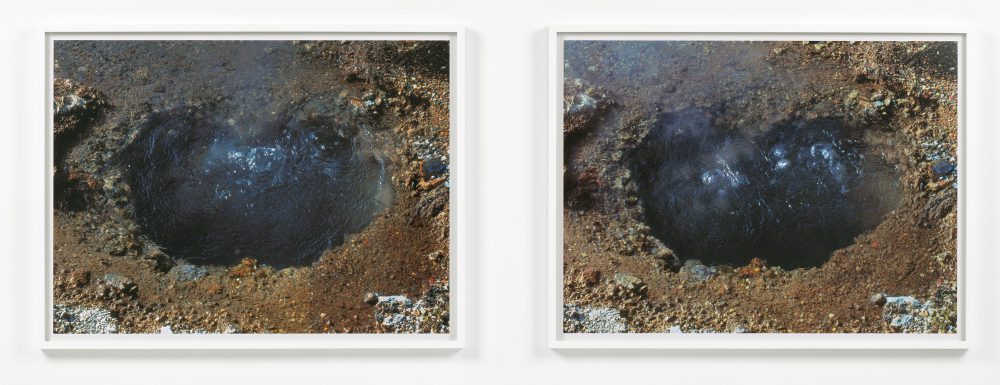
Roni Horn, Becoming a Landscape, 1999–2001. Twenty C-prints (detail). Courtesy the artist and Hauser & Wirth, Zürich. Image via Contemporary Art Daily.
I have to admit that the preponderance of landscape photography situated amidst images of bodily fragments on Grindr arrived at a time when I was looking for models with which to process the mounting catastrophes brought on by global warming. This summer and fall saw near weekly disasters: floods, earthquakes, wildfires, hurricanes, and the overwhelming fallouts for the inhabitants of affected areas. I had been looking for methodologies that can both affirm the material and emotional loss that these fluctuations on the planet have produced, while also decentering value systems that presume human survival trumps care toward the rest of the material world.
The interspersion on Grindr of plant and animal, object and space, water, sky, storm, stone, sweat, skin, and clouds may indeed be motivated on individual levels as masks for the maintenance of privacy, but taken together, a proposition forms beyond MASC 4 MASC predilections, casual hookups, dating, and anonymous sex. I’m left with a search for desires and ecological orientations that circumnavigate—or at least pluralize—the responses to an encompassing landscape in upheaval.
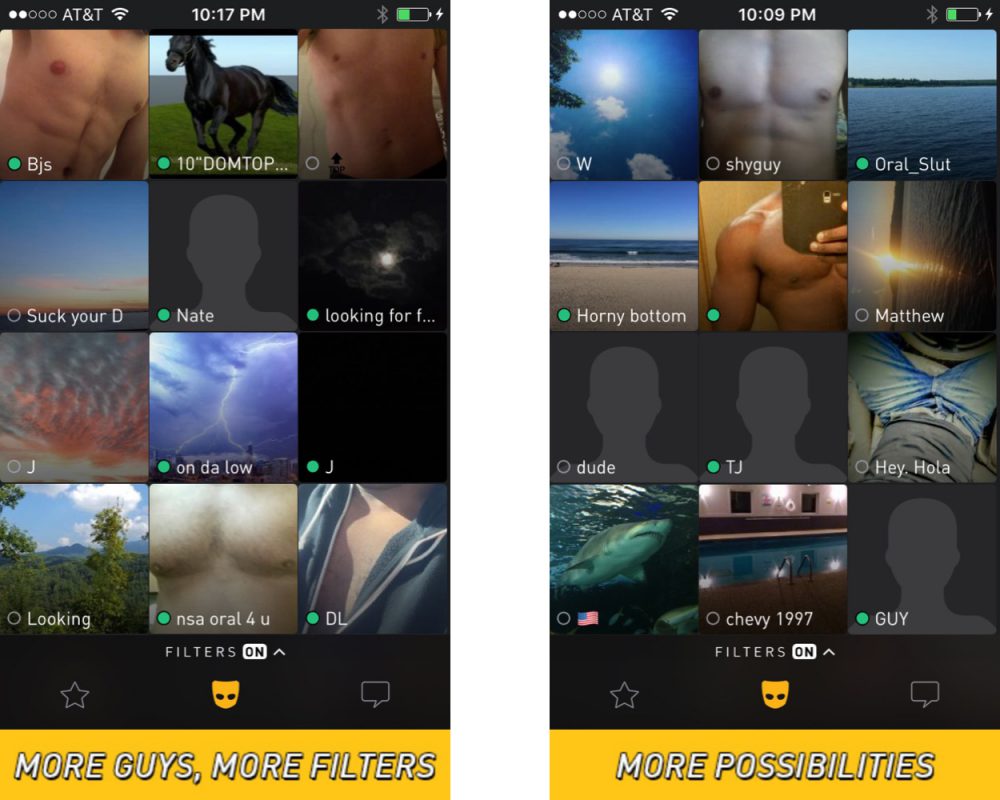
In the introduction to Donna J. Haraway’s 2016 book Staying with the Trouble: Making Kin in the Chthulucene, she writes: “The task is to make kin in lines of inventive connection as a practice of learning to live and die well with each other in a thick present…Staying with the trouble requires learning to be truly present, not as a vanishing pivot between awful or edenic pasts and apocalyptic or salvific futures, but as mortal critters entwined in myriad unfinished configurations of places, times, matters, meanings…To stay with the trouble of living and dying in response-ability on a damaged earth.”
Amidst these images of bodily landscapes I see on Grindr, I find the “myriad unfinished configurations of places, times, matters, [and] meanings” about which Haraway writes. Likewise, this has been the life work of Horn, whose practice continually draws signs of human experience out into the larger world and slips past tidy conceptualizations by which the bounds of body and space have been conventionally defined. Coming to an appreciation of these interdependencies also allows the governing problematics of our spaces to be traced and analyzed. Yet those racist, narrow-minded forms that frame territories like Grindr—which as a for-profit company ultimately uses expression of identity as a means of financial gain—often remain opaque, as such mechanisms of control tend to be, lurking deep within algorithms and naturalizing prejudice into more seemingly benign matters of taste.
Again and again, those self-defined as down low and discreet on Grindr have shown themselves to be “becoming a landscape.” As varieties of ecological forms are worked into the visualizations of bodies and desires, what it means to be down low is opened into more possible meanings, and with those multiplied stakes develop emergent ethics and sensibilities for how we exist not only with but as part of the disruptive landscape that extends around us. To be down low is to be close to the ground, as in the etymology of “humble”: low to the ground. Down low can mean staying with the trouble. Down low apparently elects to vacate the philosophical center around which nature-culture is organized. Instead, there is a willingness to be brought down low by changing seasons (and the ways the changes in seasons are changing), storms, floods, and environmental collapse—to hold these images as a means of identifying oneself. These instances of cruising the down low work against the discrete; instead, fragmentation is worked and reworked without resolve into configurations of place and desire issuing a discontinuous embodiment that flows across virtual platforms, falls into bed with strangers, and opens out across space.
Editor's Note
Thanks to my sibling Michael J. Morris with whom I’ve discussed many of these ideas in depth over years as they developed their dissertation “Material Entanglements with the Nonhuman World: Theorizing Ecosexualities in Performance,” for Ohio State University. Our ideas in these texts are as close in kinship as we are.
—Matt Morris



